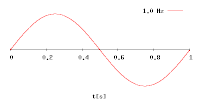Key:frequency
Jump to navigation
Jump to search
 |
| Description |
|---|
| For describing the frequency of electric power supply networks and devices, electrified railways, trolleybuses and communications devices. The unit is Hz (cycles per second). |
| Group: properties |
| Used on these elements |
| Useful combination |
|
| Status: de facto |
| Tools for this tag |
|
This key describes the frequency of:
- Power infrastructure (
power=generator,power=transformer,power=circuitpreferably and controversiallylines,cables,substationsand similar passive objects) - Electric Vehicle
charging stationsandcharge pointsto denote AC or DC power. - Electrified railways, trams, trolleybuses or other means of transportation (
railway=rail) - Communication devices for broadcasting and two-way telecommunications (
man_made=antenna,man_made=mastorman_made=tower) - Broadcast radio stations (
amenity=studio+studio=radio)
This key is for the frequency in a scientific/engineering sense. By contrast, the interval=* and duration=* keys describe the period (which is also called "frequency" in colloquial English).
Unit
The unit of the frequency is always hertz (cycles per second). Values lower than 1000 Hz should have no unit (frequency=50). For greater values, the SI units 'kHz' (frequency=423 kHz), 'MHz' (frequency=88.0 MHz), or 'GHz' (frequency=2.4 GHz) should be used. The unit should be separated by a space from the value. A decimal separator '.' should always be used.
Examples
| frequency= | 0 | For direct current. This is used for trolleybuses, trams, metros or light rail systems, as well as some railway systems (e.g. most conventional lines in Belgium, southern France, Italy, Japan, the Netherlands, Poland, Russia, the former Soviet Union, Spain, Slovenia) and continental high-voltage direct current (HVDC) lines. |
| 16.67 | For the railways with overhead lines in Sweden, Norway and Germany. In Germany only for railways which are not fed from the railway power grid (as in some regions in Mecklenburg-West Pomerania, Saxony-Anhalt and Brandenburg). | |
| 16.7 | For the railway power grids in Germany, Austria and Switzerland. Also for the railways with overhead lines, which are fed from these power grids (in Austria, Switzerland and most parts of Germany). | |
| 25 | For the railway power grids in the Northeast United States (DC, MD, DE, PA, NJ, NY) and for the railways with overhead lines fed from these power grids (e.g. the Northeast Corridor from Washington, DC to Bowery Bay Phase Break, SEPTA lines). | |
| 50 | For the power grids in Europe, Australia and most parts of Africa, eastern Japan and Asia (see Wikipedia), also for some railways with overhead lines in these countries. | |
| 60 | For the power grids in North America, most parts of South America, western Japan and some other countries (see Wikipedia), also for some railways with overhead lines in these countries. | |
| 190 - 1750 kHz | For non-directional beacons (NDBs, an aviation navigation device). For example, MIQ in Germany. | |
| 283 - 325 kHz | For beacons sending differentiated GPS corrections (so called dGPS beacons) | |
| 531 - 1701 MHz | For MF AM radio broadcasting (also 530 - 1710 MHz in the Americas). | |
| 76 - 108 MHz | For VHF FM radio broadcasting (also OIRT 65.9 - 74 MHz). | |
| 108 - 117.95 MHz | For VOR stations on Wikipedia (an aviation navigation device). For example, WLD in Germany. | |
| 470 - 960 MHz | For UHF television broadcasting |
For more details about the difference between frequency=16.67 (16 2⁄3) and frequency=16.7, consult Wikipedia.